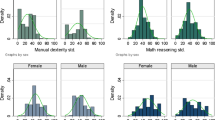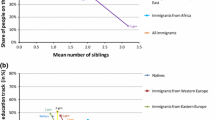Abstract
This study estimates the causal effects of language proficiency on the economic and social integration of Australian immigrants. Identifying the effects of languages on socioeconomic outcomes is inherently difficult owing to the endogeneity of language skills. Using the phenomenon that younger children learn languages more easily than older children, we construct an instrumental variable for language proficiency. To achieve this, we consider the age at arrival of immigrants who came as children from Anglophone and non-Anglophone countries. We find a significant positive effect of English proficiency on wages and promotions among adults who immigrated to Australia as children. Higher levels of English proficiency are associated with increased risk-taking, more smoking, and more exercise for men, but have considerable health benefits for women. English language proficiency has a significant influence on partner choice and a number of social outcomes, as well as on children’s outcomes, including their levels of academic achievement. The results are robust to alternative specifications, including accounting for between-sibling differences and alternative measures of English skills.

Similar content being viewed by others
Notes
One hundred and twenty-eight countries of origin are classified according to the Standard Australian Classification of Countries (SACC), 1998 (http://www.abs.gov.au/AUSSTATS/abs@.nsf/0/1837ADE79569F330CA2572680017FE07?opendocument).
The CIA World Factbook is available online (https://www.cia.gov/library/publications/the-world-factbook/).
We also consider using a parameterization that admits a degradation in language-learning ability that starts at age 12 and grows linearly (Bleakley and Chin 2004). Because the results are qualitatively similar (but less significant) and our sample size is not really sufficient (such a parameterization requires a large number of observations for each age group), we present results using the arrived-young dummy variable in most specifications.
The larger age window is the result of identifying the relationship between partners or between children and their parents.
These results are not reported here but are available upon request from the authors.
The Centrelink delivers a range of government payments and services for retirees, the unemployed, families, carers, parents, and people with disabilities, and provides services at times of major change. The majority of Centrelink’s services are the disbursement of social security payments. Job Services Australia (formerly known as the Job Network) is an Australian Government–funded network of organizations that is contracted by the Australian Government to deliver employment services to unemployed job seekers on government income support payments.
The variation in the IV estimate comes from the instrument, whereas the OLS estimate uses all the variation. If the marginal return to language proficiency affected by the instrument differs systematically from that of the population, then the coefficients estimated using OLS and IV will be different. As can be seen in columns 5–6 and 11–12 of Table 2, the binary instrument is significantly positively related to all levels of English language proficiency. However, the highest coefficient is obtained when moving to the “spoken very well” level of English language skills. Thus, IV will give a higher estimate than OLS if the greatest gains from language proficiency come from later steps toward proficiency.
Measurement errors in the language proficiency measure may affect OLS and IV differently.
We reported the results in an earlier working version of this article, which is available upon request.
IMR can be found online (http://www.gapminder.org/documentation/documentation/gapdoc002.pdf), and GDP per capita comes from Maddison (2012).
The schooling quality variables are from Barro and Lee (2001).
References
Antecol, H., Cobb-Clark, D. A., & Trejo, S. J. (2003). Immigration policy and the skills of immigrants to Australia, Canada, and the United States. Journal of Human Resources, 38, 192–218.
Barro, R., & Lee, J. (2001). Schooling quality in a cross-section of countries. Economica, 68, 465–488.
Battu, H., Seaman, P., & Zenou, Y. (2011). Job contact networks and the ethnic minorities. Labour Economics, 18, 48–56.
Bleakley, H., & Chin, A. (2004). Language skills and earnings: Evidence from childhood immigrants. Review of Economics and Statistics, 86, 481–496.
Bleakley, H., & Chin, A. (2008). What holds back the second generation? The intergenerational transmission of language human capital among immigrants. Journal of Human Resources, 43, 267–298.
Bleakley, H., & Chin, A. (2010). Age at arrival, English proficiency, and social assimilation among US immigrants. American Economic Journal: Applied Economics, 2(1), 165–192.
Borjas, J. (1990). Assimilation and the earnings of immigrants. In G. J. Borjas (Ed.), Friends or strangers: The impact of immigrants on the U.S. economy (pp. 97–115). New York, NY: Basic Books.
Brown, S., & Taylor, K. (2008). Reservation wages, expected wages and labour market outcomes: Analysis of individual level panel data (Working Paper No. 2008008). South Yorkshire, UK: University of Sheffield, Department of Economics.
Case, A., & Paxson, C. (2010). Causes and consequences of early-life health. Demography, 47, S65–S85.
Case, A., & Paxson, C. (2011). The long reach of childhood health and circumstance: Evidence from the Whitehall II Study. Economic Journal, 121, F183–F204.
Casey, T., & Dustmann, C. (2008). Intergenerational transmission of language capital and economic outcomes. Journal of Human Resources, 43, 4660–4687.
Chen, K. (2013). The effect of language on economic behavior: Evidence from savings rates, health behaviors, and retirement assets. American Economic Review, 103, 690–731.
Chiswick, B., & Miller, P. (1995). The endogeneity between language and earnings: International analyses. Journal of Labor Economics, 13, 246–288.
Clarke, A., & Skuterud, M. (2014). Immigrant skill selection and utilization: A comparative analysis of Australia, Canada, and the United States (CLSRN Working Paper No. 140). Vancouver, BC, Canada: Vancouver School of Economics.
Daneshvary, N., Herzog, H. W., Hofler, R. A., & Schlottmann, A. M. (1992). Job search and immigrant assimilation: An earnings frontier approach. Review of Economics and Statistics, 74, 482–492.
DeWalt, A. D., Berkman, N. D., Sheridan, S., Lohr, K. N., & Pignone, M. P. (2004). Literacy and health outcomes. A systematic review of the literature. Journal of General Internal Medicine, 19, 1228–1239.
Divi, C., Koss, R. G., Schmaltz, S. P., & Loeb, J. M. (2007). Language proficiency and adverse events in US hospitals: A pilot study. International Journal for Quality in Health Care, 19, 60–67.
DuBard, C. A., Garrett, J., & Gizlice, Z. (2006). Effect of language on heart attack and stroke awareness among U.S. Hispanics. American Journal of Preventative Medicine, 30, 189–196.
DuBard, C. A., & Gizlice, Z. (2008). Language spoken and differences in health status, access to care, and receipt of preventive services among US Hispanics. American Journal of Public Health, 98, 2021–2028.
Dustmann, C., & Fabbri, F. (2003). Language proficiency and labour market performance of immigrants in the UK. The Economic Journal, 113, 695–717.
Dustmann, C., & van Soest, A. (2002). Language and the earnings of immigrants. Industrial and Labor Relations Review, 55, 473–492.
Farkas, G., & Beron, K. (2004). The detailed age trajectory of oral vocabulary knowledge: Differences by class and race. Social Science Research, 33, 464–497.
Ferguson, W. J., & Candib, L. M. (2002). Culture, language, and the doctor-patient relationship. Family Medicine, 34, 353–361.
Frijters, P., Shields, M., & Price, S. (2005). Job search methods and their success: A comparison of immigrants and natives in the UK. Economic Journal, 115, F359–F376.
Funkhouser, E., & Ramos, F. A. (1993). The choice of migration destination: Dominican and Cuban Americans to the mainland United States and Puerto Rico. International Migration Review, 27, 537–556.
Gandhi, T. K., Burstin, H. R., Cook, E. F., Puopolo, A. L., Haas, J. S., Brennan, T. A., & Bates, D. W. (2000). Drug complications in outpatients. Journal of General Internal Medicine, 15, 149–154.
Hampers, L. C., Cha, S., Gutglass, D. J., Binns, H. J., & Krug, S. E. (1999). Language barriers and resource utilization in a pediatric emergency department. Pediatrics, 103, 1253–1256.
Hart, B., & Risley, T. (1995). Meaningful differences in the everyday experience of young American children. Baltimore, MD: Paul H. Brookes Publishing.
Hu, D. J., & Covell, R. M. (1986). Health care usage by Hispanic outpatients as function of primary language. Western Journal of Medicine, 144, 490–493.
Institute of Medicine. (2010). Race, ethnicity, and language data: Standardization for health care quality improvement (Institute of Medicine report). Rockville, MD: Agency for Healthcare Research and Quality. Retrieved from http://www.ahrq.gov/research/findings/final-reports/iomracereport/index.html
Jasso, G., & Rosenzweig, M. R. (2008). Selection criteria and the skill composition of immigrants: A comparative analysis of Australian and U.S. employment immigration (IZA Discussion Paper No. 3564). Bonn, Germany: Institute for the Study of Labor.
Kang, S., Howard, D., Kim, J., Payne, J. S., Wilton, L., Kim, W., & Maramba, D. (2010). English language proficiency and lifetime mental health service utilization in a national representative sample of Asian Americans in the USA. Journal of Public Health, 32, 431–439.
Kirkman-Liff, B., & Mondragon, D. (1991). Language of interview: Relevance for research of Southwest Hispanics. American Journal of Public Health, 81, 1399–1404.
Lenneberg, E. H. (1967). Biological foundation of language. New York, NY: Wiley.
Maddison, A. (2012). Statistics on world population, GDP and per capita GDP, 1–2008 AD [Data file]. Groningen, The Netherlands: University of Groningen.
Meng, X., & Gregory, R. G. (2005). Intermarriage and the economic assimilation of immigrants. Journal of Labor Economics, 23, 135–174.
Pungello, E., Iruka, I., Dotterer, A., Mills-Koonce, R., & Reznick, J. (2009). The effects of socioeconomic status, race, and parenting on language development in early childhood. Developmental Psychology, 45, 544–557.
Schachter, A., Kimbro, R. T., & Gorman, B. K. (2012). Language proficiency and health status: Are bilingual immigrants healthier? Journal of Health and Social Behavior, 53, 124–145.
Stevens, G., & Swicegood, G. (1987). The linguistic context of ethnic endogamy. American Sociological Review, 52, 73–82.
Swicegood, G., Bean, F., Stephen, E., & Opitz, W. (1988). Language usage and fertility in the Mexican-origin population of the United States. Demography, 25, 17–33.
Weinick, R. M., & Krauss, N. A. (2000). Racial/ethnic differences in children’s access to care. American Journal of Public Health, 90, 1771–1774.
Acknowledgments
We thank Alicia Adsera, Claudia Senik, Steven Stillman, Hee-Seung Yang, Paul Miller, Amee Chin, Chau Nguyen, Abdurrahman Aydemir, Deborah Ann-Cobb Clark, and participants at the HILDA conference in 2013 and at the University of Melbourne-Princeton University Workshop on International Perspectives on Immigration, as well as seminar participants at Flinders University, Monash University, and Bilkent University for comments and suggestions on earlier drafts. Any remaining errors are our own. Islam gratefully acknowledges funding support from the Australian Research Council (DE120101588).
Author information
Authors and Affiliations
Corresponding author
Rights and permissions
About this article
Cite this article
Guven, C., Islam, A. Age at Migration, Language Proficiency, and Socioeconomic Outcomes: Evidence From Australia. Demography 52, 513–542 (2015). https://doi.org/10.1007/s13524-015-0373-6
Published:
Issue Date:
DOI: https://doi.org/10.1007/s13524-015-0373-6




